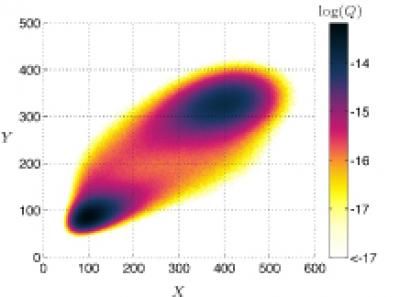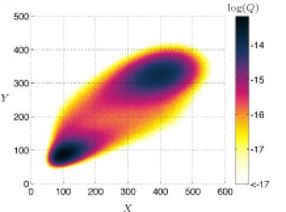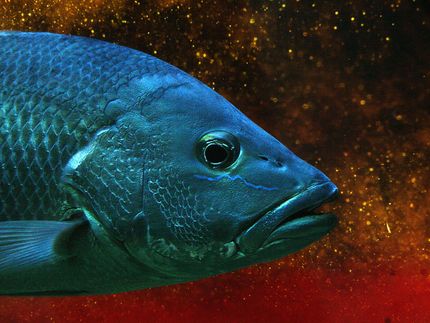Predator-prey made simple
New method simplifies studies of predator-prey interactions and other 'bistable' systems
A team of U.K. researchers has developed a way to dramatically reduce the complexity of modeling "bistable" systems which involve the interaction of two evolving species where one changes faster than the other ("slow-fast systems"). Described in The Journal of Chemical Physics, the work paves the way for easier computational simulations and predictions involving such systems, which are found in fields as diverse as chemistry, biology and ecology.

Computed stationary density of a slow-fast system with metastable transitions is shown.
M. Bruna/University of Oxford

This image shows the evolution of a prey (blue line) and predator (green line) system in three parameter regimes: from the low extinction risk in Regime 1 to the high extinction risk in Regime 3.
M. Bruna/University of Oxford


Imagine, for instance, trying to predict how a population of whales would fare based on the impact of fluctuating ocean levels of plankton, if that was their primary food source. It might seem easy enough to estimate how many happy whales you will have given a relatively constant supply of plankton, but it's much harder to reckon what will happen to the population when their food source fluctuates dramatically.
That's much closer to reality: over their lifetimes, your average whale could endure multiple feasts and famines according to plankton's fickle blooms, and accurately predicting the impacts these will have on the whale population are made possible only by accounting for both the slow whale population dynamics and the much faster and widely fluctuating plankton population dynamics. This situation can be represented as a classic "bistable" problem: conceptually challenging, mathematically complicated, computationally intensive and, until now, nearly impossible to solve.
But hitting upon a solution that was in itself somewhat bistable, Maria Bruna and colleagues at the University of Oxford's Mathematical Institute and at Microsoft Research's Computational Science Laboratory in Cambridge, England developed a new method for deriving simpler models of bistable system.
Their solution involved combining two existing mathematical techniques called "slow manifold theory," which is applied to slow-fast systems; and "perturbation theory," which is used for the study of metastable transitions. They tested this approach against the more standard, computationally expensive model that exhaustively treated the fast processes to predict the slow. What their results showed was that their simpler method worked just as well at predicting the slow process. Then they applied this to a predator-prey model and showed that it could accurately calculate the time to extinction of the predator (the slow species, like the whale) when the abundance of its prey (the fast species, like the plankton) fluctuates around two alternative states.
A key advantage of the new approach is that it allowed the researchers to obtain the accurate time-dependent behavior of the slow variable, in contrast to earlier methods that are only useful to compute equilibrium quantities.
"Using this method one can obtain accurate simulations of the process of interest that take into account the effect of the fast bistable processes, but much more cheaply," Bruna said.
"Since the reduction method is systematic, it can be easily applied to other systems and extended to higher dimensions," she added. For instance, the method could be extended to help understand why some ecosystems, consisting of multiple fast-slow interaction processes, fail to return to their original state after being perturbed by harvesting.
Other news from the department science

Get the chemical industry in your inbox
By submitting this form you agree that LUMITOS AG will send you the newsletter(s) selected above by email. Your data will not be passed on to third parties. Your data will be stored and processed in accordance with our data protection regulations. LUMITOS may contact you by email for the purpose of advertising or market and opinion surveys. You can revoke your consent at any time without giving reasons to LUMITOS AG, Ernst-Augustin-Str. 2, 12489 Berlin, Germany or by e-mail at revoke@lumitos.com with effect for the future. In addition, each email contains a link to unsubscribe from the corresponding newsletter.
Most read news
More news from our other portals
Last viewed contents

A nanoscale view of bubble formation - A new model now describes the boiling process with much greater precision
Caspofungin
Coral_(precious)
Cefazolin

Perturbations simplify the study of “super photons” - A study gives novel insight into properties which are often difficult to observe

The FRITSCH Variable Speed Rotor Mill PULVERISETTE 14 premium line was granted two awards - The INDUSTRIEPREIS 2016 - Best of 2016 - and Best Products award of the EuroLab 2016



























































